Golden Prague
Vitejte u multikese urcene predevsim pro turisty jako pruvodce po historickem centru.
Prijeli jste do Prahy a mate volne odpoledne na prohlidku mesta a zaroven byste radi posbirali par kesi? Pak můzete zkusit treba tuto multinku, ktera Vas provede po tom nejzajimavejsim, co historicka Praha nabizi. Cesta po zajimavostech na obou brezich Vltavy ma asi 10 km, zabere Vam priblizne 3 – 4 hodiny casu a je vhodna na prijemnou odpoledni prochazku.
Cesta Vas provede v trase zanikleho projektu Silver Line z roku 2006. Extremne levneho tisteneho průvodce uz sice nesezenete, nicmene celou cestu Vas stale jeste budou provazet zelezne znacky na chodniku.
Kes je okruzni, jedna se vlastne o velky okruh po Starem Meste a maly okruh pres Hradcany. Oba okruhy můzete zacit na Karlove moste, ale i kdekoli jinde, lov můzete rozdelit na vice casti, jit se da v obou smerech, zkratka moznosti je vice a je jen na Vas, jak si to projdete. Na kazde zastavce zjistite jednu indicii - jednociferne promenne jsou znaceny jednim pismenem, dvouciferne dvema pismeny, napr. AA. Vzhledem k omezene kapacite stazenych listignu v gpskach je vzorec pro nalezeni kese hned na zacatku. Stejne tak popis indicii naleznete po ceste primo ve waypointech, takze neni nutne u kazde zastavky znovu chodit do listingu kese.
Preji Vam stastnou cestu a pekne si uzijte prochazku nasim krasnym mestem.
Kes naleznete kazdy den krome utery od 10:00 do 16:30 na:
50°(A+C+H+M+O+X+Y)*(E+G+L+P+R+U+V)
14°(B+F+K+N+Q+T+Z)*(D+I+J+O+S+W)
Kontrolni soucet hodnot A - Z je 464.
Incicie si muzete zkontrolovat v Multi-checkeru:

Pro detailni hint zkuste Geocheck:

Multicache designed in particular for tourists as a guide around the historical centre.
Have you arrived to Prague having an afternoon off for a tour of the city and you would like to grab some caches at the same time? Then you can try this multi which will guide you around the most interesting places Prague can offer. The tour around sights on both sides of Vltava river is about 10 km long, it will take about 3-4 hours, a convenient afternoon walk. The tour will take you in trace of a vanished project Silver Line from 2006. You will probably not be able to get a cheap printed guidebook any more, but the iron marks on the pavement will still guide you on your way.
The tour is circular, you will actually do a big circle around Old Town and a small circle through the Castle District. You can start both circles on the Charles Bridge, or anywhere else. You can divide the hunt into more parts, you can go in both directions, so it is upon you, how to make your way through Golden Prague. As the capacity of dowloaded listings to gps is limited, the final formula is right on the beginning of the listing. Also the stage decriptions are shown in the waypoints, so you will not need to go to the listing on every stop.
Have a nice journey and enjoy a pleasant walk around the beautiful city of Prague.
And a big thanks to John Nash, who made the marvelous translation of all stages!
Cache can be found every day except Tuesdy from 10:00 to 17:00 on:
50°(A+C+H+M+O+X+Y)*(E+G+L+P+R+U+V)
14°(B+F+K+N+Q+T+Z)*(D+I+J+O+S+W)
Checksum of values A - Z is 464.
You can check your values in Multi-checker.
For detailed hint try Geocheck.
A – Karluv most / Charles Bridge
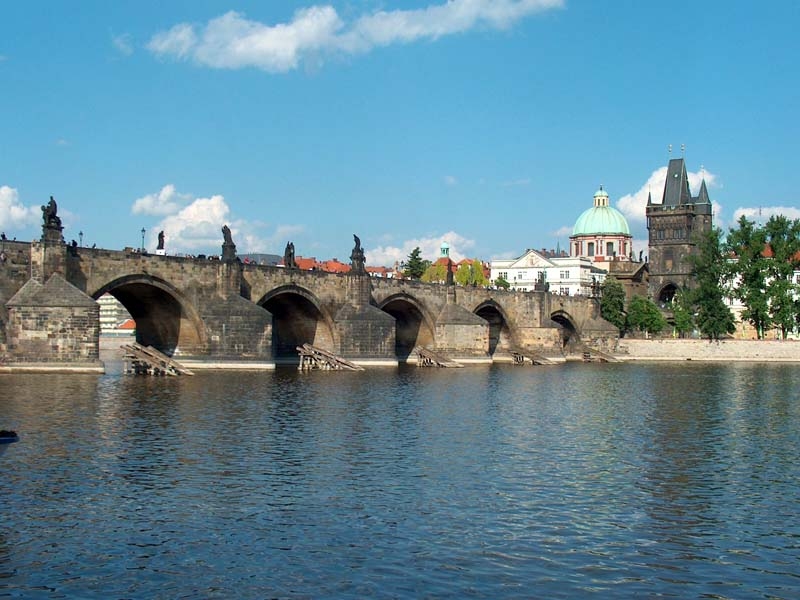 Svou cestu muzete zacit na Karlove moste. Byl postaven v letech 1357-1400 po tom, co predchozi most Juditin strhla roku 1342 povoden. Zajimavosti je, ze podle povesti byl Karlem IV. zakladni kamen polozen roku 1357, 9.7. v 5:31, tedy 1-3-5-7-9-7-5-3-1. Tomuto datu odpovidala zaroven prizniva konstelace Slunce a Saturnu, a tak astrologove povazovali tento moment jako vhodny pro zacatek vystavby. Zjevne se to vyplatilo, most prezil nekolik povodni a stoji tu dodnes.
Svou cestu muzete zacit na Karlove moste. Byl postaven v letech 1357-1400 po tom, co predchozi most Juditin strhla roku 1342 povoden. Zajimavosti je, ze podle povesti byl Karlem IV. zakladni kamen polozen roku 1357, 9.7. v 5:31, tedy 1-3-5-7-9-7-5-3-1. Tomuto datu odpovidala zaroven prizniva konstelace Slunce a Saturnu, a tak astrologove povazovali tento moment jako vhodny pro zacatek vystavby. Zjevne se to vyplatilo, most prezil nekolik povodni a stoji tu dodnes.
Asi nejzajimavejsi sochou mostu je Jezis Nazaretsky. Vas bude zajimat rimske cislo AA na poslednim radku prostredni desky za sloven DIE. A=14
You can start your trip on the Charles Bridge. It was built in 1357-1400 after its predecessor Judith Bridge had been destroyed by flood in 1342. According to a legend, the foundation-stone was laid by king Charles IV in 1357, 9th July, at 5:31, giving together 1-3-5-7-9-7-5-3-1. There was also a good constellation of the Sun and Saturn in that moment, so astrologists claimed this to be a good time for the start of the construction. After all, it was probably a good decision as the bridge has survived several floods and stands here until today.
Probably the most interesting statue on the bridge is Jesus of Nazareth. Note the roman number AA on the last line of the middle tablet after word DIE. A=14.
B – Narodni divadlo / National Theatre
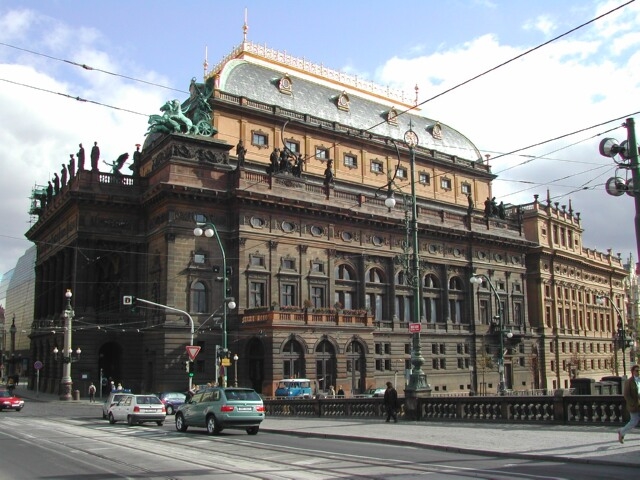 Bylo otevreno roku 11. cervna 1881 slavnostni premierou Smetanovy Libuse. Po dvanacti predstavenich byla uzavreno, aby se dokoncily posledni upravy. Definitivni otevreni bylo stanoveno na 11. zari, ale nakonec se tento den neotviralo. V srpnu totiz doslo pri instalaci hromosvodu na strese neopatrnosti klempiru k pozaru, diky nemuz cele divadlo vyhorelo. Projevila se zde vsak velka obetavost a houzevnatost ceskeho naroda, ktery za 47 dni ve sbirce nasbiral milion zlatych, aby mohlo byt divadlo opraveno. Od toho take pochazi napis nad oponou Narod sobe. Znovu otevreno bylo 18.11.1883 opet operou Libuse.
Bylo otevreno roku 11. cervna 1881 slavnostni premierou Smetanovy Libuse. Po dvanacti predstavenich byla uzavreno, aby se dokoncily posledni upravy. Definitivni otevreni bylo stanoveno na 11. zari, ale nakonec se tento den neotviralo. V srpnu totiz doslo pri instalaci hromosvodu na strese neopatrnosti klempiru k pozaru, diky nemuz cele divadlo vyhorelo. Projevila se zde vsak velka obetavost a houzevnatost ceskeho naroda, ktery za 47 dni ve sbirce nasbiral milion zlatych, aby mohlo byt divadlo opraveno. Od toho take pochazi napis nad oponou Narod sobe. Znovu otevreno bylo 18.11.1883 opet operou Libuse.
Na rohu krizovatky si povsimnete tri modrych desticek pod ceduli Narodni. Na vsech trech se vyskytuje v hornim radku dvoumistne cislo BB.
The Theatre was opened on 11 July 1881 with a festive premiere of Smetana’s opera Libuse. It was closed after 12 performances to finish the last arrangements. The date for the definitive opening was set for 11 September, but it was not kept in the end due to a fire caused by careless plumbers during installation of a lightning conductor on the roof. The whole theatre burnt down. Czech people proved their great persistence and self-sacrifice, they collected a million of guldens in 47 days for the repair of the whole theatre. This gave birth to the title above the curtain: People to themselves. The theatre was reopened on 18 November 1883 again with opera Libuse.
Notice three blue plates on the corner of the crossroad under the sign Narodni. There is a two-digit number BB in the top line of all three of them.
C – Rotunda sv. Krize Mensiho / Church of the Holy Cross
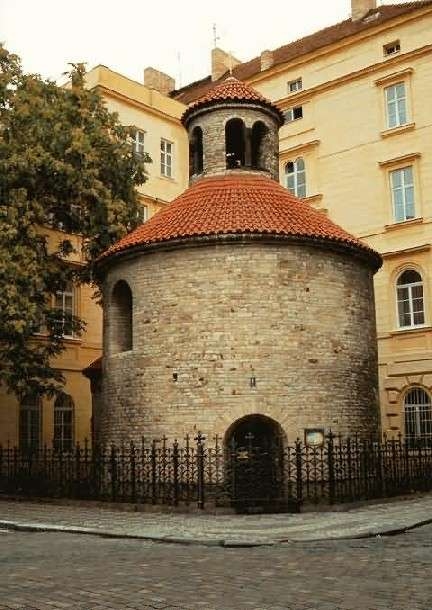 Nejstarsi prazska rotunda pochazi z konce 11. stoleti a patri tak mezi nejstarsi dochovane prazske stavby vubec. Byla vybudovana na tehdejsi dulezite obchodni ceste vedouci z Vysehradu k prechodum pres Vltavu. Na jejich zdech jsou dochovane zbytky gotickych maleb. V polovine 19. stoleti mela byt stavba pro svuj dezolatni stav dokonce odstranena, coz se nastesti nestalo diky spolku Umelecka beseda. Misto toho ji potkala v letech 1853-1865 rekonstrukce, diky niz je tu dodnes.
Nejstarsi prazska rotunda pochazi z konce 11. stoleti a patri tak mezi nejstarsi dochovane prazske stavby vubec. Byla vybudovana na tehdejsi dulezite obchodni ceste vedouci z Vysehradu k prechodum pres Vltavu. Na jejich zdech jsou dochovane zbytky gotickych maleb. V polovine 19. stoleti mela byt stavba pro svuj dezolatni stav dokonce odstranena, coz se nastesti nestalo diky spolku Umelecka beseda. Misto toho ji potkala v letech 1853-1865 rekonstrukce, diky niz je tu dodnes.
Na krizovatce pred rotundou si povsimnete na narozi jednoho z domu letopoctu 18C0.
The oldest rotunda in Prague, one of the oldest preserved buildings in Prague at all, comes from 11th century. It was built on an important trade route coming from Vysehrad to the Vltava crossings. There are preserved remnants of Gothic paintings on the walls. The building should have been taken down in the middle of 19th century because of its devastation. Fortunately, it did not happen thanks to an association called Umelecka beseda (Artistic Association). Instead, the rotunda was reconstructed in 1853-1865 and stands there until today.
On the crossroad in a front of the rotunda notice the year 18C0 on the corner of one of the houses.
D – Betlemska kaple / Bethlehem Chapel
 Puvodni kaple byla postavena roku 1391 a byla jednou z nejoblibenejsich mist bohosluzeb. Kazal zde Mistr Jan Hus a dalsi husitsti knezi. Pozdeji kaple chatrala, az byla roku 1786 zbourana. Obnovy se dockala v 50. letech 20. stoleti, jako pamatnik husitskeho hnuti.
Puvodni kaple byla postavena roku 1391 a byla jednou z nejoblibenejsich mist bohosluzeb. Kazal zde Mistr Jan Hus a dalsi husitsti knezi. Pozdeji kaple chatrala, az byla roku 1786 zbourana. Obnovy se dockala v 50. letech 20. stoleti, jako pamatnik husitskeho hnuti.
Proti kapli si na narozi opet vsimnete ctyr desticek pod ceduli Betlemske namesti. I zde se na vsech opakuje dokonce petkrat stejne cislo DD.
The original chapel was built in 1391 and used to be one of the most favorite places of worship. It is a place where Master Jan Hus and other Hussite priests preached. Later the chapel decayed, until it was torn down in 1786. It was restaured in the 1950s as a monument of the Hussite movement.
Notice four small plates under the sign Betlemske namesti opposite to the chapel. You can see the same number DD repeated even five times here.
E – Kubisticka lampa / Cubist Lamp
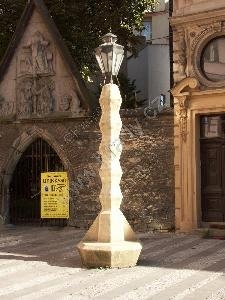 Unikatni kubisticka lampa v rohu Jungamannova namesti je dilem Emila Kralicka. Kubismus se v architekture projevil pouze v Ceskoslovensku, takze alespon jednim stylem jsme prispeli do tisicilete studnice architektonickych dejin. Prestoze je lampa ponekud zastrcena, jedna se o naprosty svetovy unikat.
Unikatni kubisticka lampa v rohu Jungamannova namesti je dilem Emila Kralicka. Kubismus se v architekture projevil pouze v Ceskoslovensku, takze alespon jednim stylem jsme prispeli do tisicilete studnice architektonickych dejin. Prestoze je lampa ponekud zastrcena, jedna se o naprosty svetovy unikat.
Lampa je pravidelny E-uhelnik.
Unique Cubist lamp in the corner of Jungmann Square was made by Emil Kralicek. Cubism in architecture was used only in Czechoslovakia, so at least through this style we have contributed to the thousand-year-old architectonic history. Even though the lamp is a little bit off, it is a world unique.
The lamp is a regular E-angle.
F – Stavovske divadlo / Stavovske Theatre
 Puvodne Nosticovo divadlo bylo vybudovano v letech 1781-1783. Navrh byl evidentne velmi inspirovan petrohradskym Zimnim palacem postavenym o 20 let drive, ktery vypada velmi podobne, pouze meritko je o rad jine. Prvni ceskou hrou hranou ve Stavovskem divadle bylo historicke drama se zpevy Bretislav a Jitka od Vaclava Thama.
Puvodne Nosticovo divadlo bylo vybudovano v letech 1781-1783. Navrh byl evidentne velmi inspirovan petrohradskym Zimnim palacem postavenym o 20 let drive, ktery vypada velmi podobne, pouze meritko je o rad jine. Prvni ceskou hrou hranou ve Stavovskem divadle bylo historicke drama se zpevy Bretislav a Jitka od Vaclava Thama.
Krome zajimave sochy nalevo od vstupu si vsimnete kolik je v podloubi lamp osvetleni. Pocitejte lucerny i zemni svetla, dohromady je jich celkem F.
Originally Nostic Theatre was built in 1781-1783. The design was apparently inspired with the Winter Palace in St. Petersburg built 20 years earlier, which looks very similar, only the size scale is different. The first Czech play performed in the theatre was a historical drama with singing Bretislav and Jitka by Vaclav Tham.
Except for an interesting statue on the left side of the entrance, notice how many lamps light inside of the arcade. Count the lanterns as well as the ground lamps, you will find F of them altogether.
G – Dum u Cerne Matky Bozi / House of the Black Madonna
 Dum u Cerne Matky Bozi je vrcholnym dilem ceskeho kubismu. Byl postaven roku 1912 podle projektu J. Gocara a je asi nejznamejsim kubistickym domem vubec. Pokud mate chvili casu, muzete zajit dovnitr, kde najdete kubisticky zarizenou kavarnu.
Dum u Cerne Matky Bozi je vrcholnym dilem ceskeho kubismu. Byl postaven roku 1912 podle projektu J. Gocara a je asi nejznamejsim kubistickym domem vubec. Pokud mate chvili casu, muzete zajit dovnitr, kde najdete kubisticky zarizenou kavarnu.
Kazdopadne si ale vsimnete, ze dum ma vcetne tech stresnich celkem G nadzemnich podlazi. (G je sude.)
The House of the Black Madonna is mature work of the Czech cubism. It was built in 1912 according to the design of J. Gocar and it is probably the best-known cubist house at all. If you have a little time, you can go inside to the cafe in the cubist style.
Be sure to notice that the house has G floors, including the roof ones. (G is even.)
H – Obecni dum a Prasna brana / Municipal House and Powder Tower
 Jste na zacatku Kralovske cesty vedouci od Prasne brany na Prazsky hrad. Tuto trasu jeste nekolikrat po ceste prekrocite. Obecni dum z roku 1912 je jednou z nejvyznamnejsich ceskych secesnich staveb. Stoji na miste puvodniho Kralovskeho palace, ktery nechal vybudovat kolem roku 1380 Vaclav IV.
Jste na zacatku Kralovske cesty vedouci od Prasne brany na Prazsky hrad. Tuto trasu jeste nekolikrat po ceste prekrocite. Obecni dum z roku 1912 je jednou z nejvyznamnejsich ceskych secesnich staveb. Stoji na miste puvodniho Kralovskeho palace, ktery nechal vybudovat kolem roku 1380 Vaclav IV.
Na Prasne brane si vsimnete nivelacni znacky s cislem 196°97HH.
You are at the beginning of the Royal Road leading from the Powder Tower to the Prague Castle. You will cross this route a few times more. The Municipal House from 1912 is one of the most significant Czech Secession buildings. It stands on the site of the original Royal Palace which was built by Vaclav IV around 1380.
Notice the leveling mark on the Powder Tower bearing number 196°97HH.
I – Kostel sv. Jakuba Vetsiho / Church of St. Jacob the Bigger
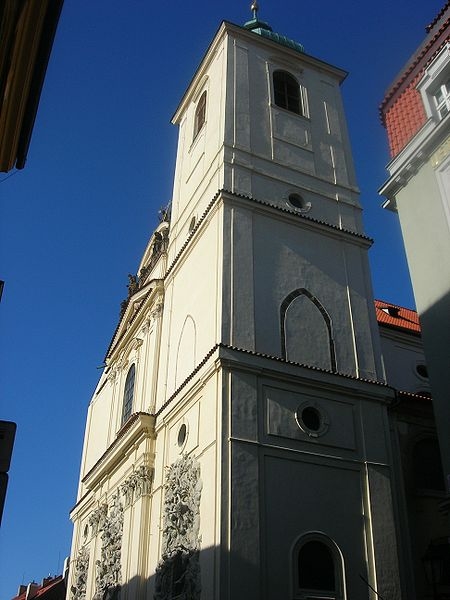 Jste u puvodne gotickeho kostela, ktery byl pozdeji barokne prestaven. Jedna se o jeden z nejvetsich prazskych kostelu, na jehoz severni stranu navazuje jezuistsky klaster. Opet pokud mate chvili casu navic, kouknete se dovnitr, jsou zde nadherne varhany, diky nimz se zde konaji pravidelne varhanni koncerty.
Jste u puvodne gotickeho kostela, ktery byl pozdeji barokne prestaven. Jedna se o jeden z nejvetsich prazskych kostelu, na jehoz severni stranu navazuje jezuistsky klaster. Opet pokud mate chvili casu navic, kouknete se dovnitr, jsou zde nadherne varhany, diky nimz se zde konaji pravidelne varhanni koncerty.
Na dome vlevo vedle kostela si ale urcite vsimnete ve vyklenku sochy, na jejimz pozadi je velka zlata musle. Tato musle ma II dvoj-poli. (II neni delitelne ctyrmi.)
You are at the originally gothic church which was later rebuilt in the baroque style. If you have a little spare time, go inside to see the wonderful organ.
On the house to the left from the church, be sure to notice a statue in the niche with a big golden shell in the background. This shell has II double-fields. (II is not divisible by four.)
J – Tynsky chram / Church of Our Lady Before Tyn
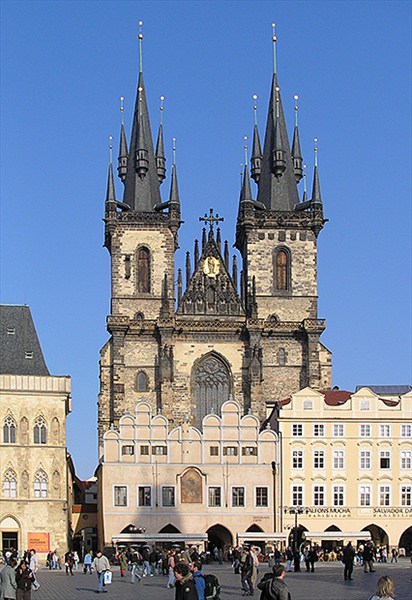 Prochazite kolem jednoho z nejvyznamnejsich prazskych kostelu. Uz od 11. stoleti zde byval romansky kostelik. Ten nahradil ve 14. stoleti tento vrcholne goticky chram. Jeho architekturu ovlivnily mistri z prazske katedralni huti Matyase z Arrasu a zejmena Petra Parlere. K nemu odkazuji kruzby oken hlavni lodi a zejmena okno zapadniho pruceli o vysce 28 m a velkolepe socharsky zpracovany severni portal.
Prochazite kolem jednoho z nejvyznamnejsich prazskych kostelu. Uz od 11. stoleti zde byval romansky kostelik. Ten nahradil ve 14. stoleti tento vrcholne goticky chram. Jeho architekturu ovlivnily mistri z prazske katedralni huti Matyase z Arrasu a zejmena Petra Parlere. K nemu odkazuji kruzby oken hlavni lodi a zejmena okno zapadniho pruceli o vysce 28 m a velkolepe socharsky zpracovany severni portal.
Pri pruchodu od sv. Jakuba na Staromestske namesti podejdete mostek vedouci z chramu do bocniho domu. Z obou stran je na nem celkem J ovalnych oken.
You are passing around one of the most significant Prague churches. A roman church stood here since 11th century. It was replaced by this Gothic temple. Its architecture was influenced by masters of Prague cathedral works of Matyas of Arras and Petr Parler. You can recognize that from the tracery of the windows in the main body and especially the window in the Western facade which is 28m high, as well as the monumental sculptural work of the Northern portal.
When passing from St. Jacob to the Old Town Square you will undergo a small bridge leading from the church to the side house. There are altogether J oval-shaped windows on both sides of the bridge.
K – Dum u Kamenneho zvonu / House At The Stone Bell
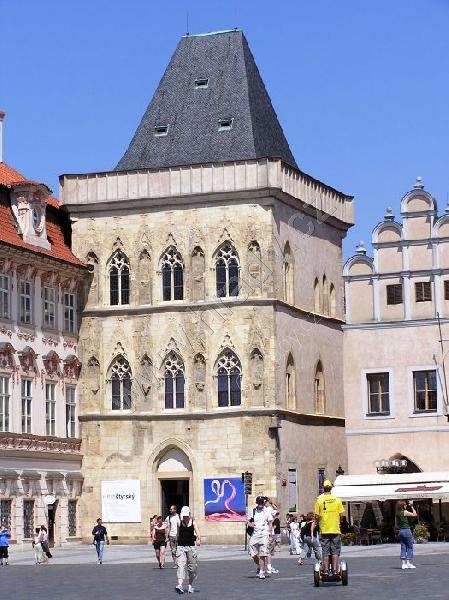 Jste na Staromestskem namesti, centru stredoveke Prahy. Je zde toho take mnoho k videni, a tak zde jsou hned ctyri stage. Vzacne dochovany Dum u Kamenneho zvonu, kolem ktereho jste nejspis prisli, je mimoradnou gotickou palacovou architekturou vezoveho charakteru z poloviny 14. stoleti. Byl vybudovan jako palac pro kralovskou rodinu, predevsim pro Elisku Premyslovnu.
Jste na Staromestskem namesti, centru stredoveke Prahy. Je zde toho take mnoho k videni, a tak zde jsou hned ctyri stage. Vzacne dochovany Dum u Kamenneho zvonu, kolem ktereho jste nejspis prisli, je mimoradnou gotickou palacovou architekturou vezoveho charakteru z poloviny 14. stoleti. Byl vybudovan jako palac pro kralovskou rodinu, predevsim pro Elisku Premyslovnu.
Na vstupnich dverich si vsimnete vystouplych nytu v peti radach velkych asi 1 cm. Je jich na obou stranach dveri celkem KK. Pozor na spodni radu, je jich tam jiny pocet.
You are on the Old Town Square, centre of the medieval Prague. There is a lot to see, therefore there are four stages. Rarely preserved House At the Stone Bell which you probably passed by, is an extraordinary gothic palace architecture of the tower character from 14th century. It was built as a palace for the royal family, especially for Eliska Premyslovna.
On the entrance door, notice the exerted rivets in five rows about 1 cm big. There are KK of them on both side of the door. Look at the lower row carefully, there is a different quantity of them.
L – Mistr Jan Hus
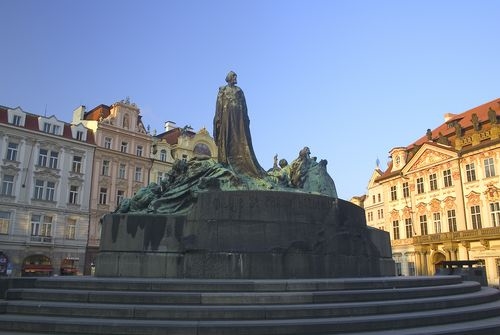 Mistr Jan Hus (asi 1370 Husinec – 6. cervence 1415 Kostnice) byl rimskokatolicky knez, cesky stredoveky nabozensky myslitel, reformator a kazatel, mistr a rektor prazske univerzity. Ve svych nabozenskych pracich kritizoval mravni upadek, v nemz se ocitla katolicka cirkev. Ta ho oznacila za kacire, jeho uceni za herezi a exkomunikovala jej (1411). Na Kostnickem koncilu byl odsouzen jako kacir a vydan svetske moci k upaleni na hranici, kdyz odmitl odvolat sve uceni. V roce 1999 prohlasil papez Jan Pavel II., ze lituje krute smrti Jana Husa a uznal ho jako reformatora cirkve.
Mistr Jan Hus (asi 1370 Husinec – 6. cervence 1415 Kostnice) byl rimskokatolicky knez, cesky stredoveky nabozensky myslitel, reformator a kazatel, mistr a rektor prazske univerzity. Ve svych nabozenskych pracich kritizoval mravni upadek, v nemz se ocitla katolicka cirkev. Ta ho oznacila za kacire, jeho uceni za herezi a exkomunikovala jej (1411). Na Kostnickem koncilu byl odsouzen jako kacir a vydan svetske moci k upaleni na hranici, kdyz odmitl odvolat sve uceni. V roce 1999 prohlasil papez Jan Pavel II., ze lituje krute smrti Jana Husa a uznal ho jako reformatora cirkve.
Na ctyrech stranach sousosi jsou napisy s odlisne zobrazenymi pismeny O. Je jich celkem LL.
Jan Hus (about 1370 Husinec – 6 July 1415 Constance) was a roman catholic priest, Czech medieval religious philosopher, reformer and preacher, professor and rector of the Prague university. He criticized the moral decay of the Catholic Church in his works. The Church declared him to be a heretic, his teaching to be heresy and excommunicated him (1411). He was sentenced at the Constance Council as a heretic and extradited to the secular power to be burned to death on a stake after he refused to deny his teaching. In 1999 the Pope John Paul II expressed regrets for the cruel death of Jan Hus and recognized him as the reformer of the Church.
On four sides of the sculpture there are inscriptions with different letters O. There are LL of them.
M – Staromestsky orloj / Prague Astronomical Clock
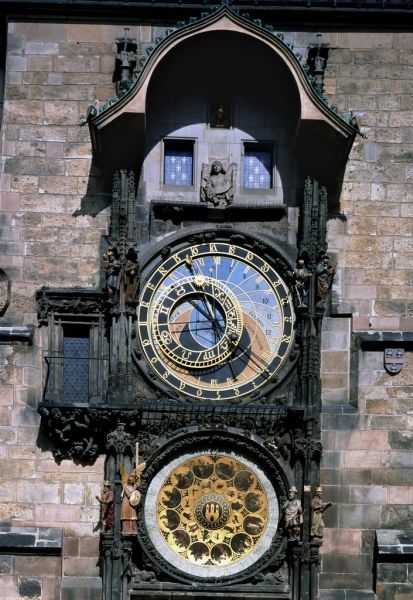 Staromestsky orloj zkonstruovany roku 1410 je jednim z nejznamejsich na svete. Orloj ma tri hlavni casti. Nejzajimavejsi je astronomicka cast, ukazujici polohy nebeskych teles. Pod ni je umisteno kalendarove kolo, ktere v 19. stoleti vybavil malbami malir Josef Manes. Kolem astronomicke casti jsou pak umisteny pohyblive figury pro pobaveni divaku. Dulezitou soucasti je take pohyblive procesi dvanacti apostolu, kteri se ukazuji kazdou hodinu nad astronomickou casti. Takze pokud tu budete tesne pred celou hodinou, stoji za to si na odbijeni pockat.
Staromestsky orloj zkonstruovany roku 1410 je jednim z nejznamejsich na svete. Orloj ma tri hlavni casti. Nejzajimavejsi je astronomicka cast, ukazujici polohy nebeskych teles. Pod ni je umisteno kalendarove kolo, ktere v 19. stoleti vybavil malbami malir Josef Manes. Kolem astronomicke casti jsou pak umisteny pohyblive figury pro pobaveni divaku. Dulezitou soucasti je take pohyblive procesi dvanacti apostolu, kteri se ukazuji kazdou hodinu nad astronomickou casti. Takze pokud tu budete tesne pred celou hodinou, stoji za to si na odbijeni pockat.
Kazdopadne si uprostred nad orlojem vsimnete male vezicky, na ktere je celkem M zlatych kouli. (M je prvocislo a neni to 5.)
The Astronomical Clock built in 1410 is one of the most famous in the world. The Clock has three main parts. The most interesting one is the astronomical part depicting the positions of the spheres. Underneath there is the calendar dial which was painted by painter Josef Manes in 19th century. Around the astronomical part there are moving figures for the entertainment of the public. An important part is the moving walk of the twelve apostles which show themselves each hour over the astronomical part. So if you are here slightly before full hour, it is worth waiting to see it.
Notice the small tower in the middle over the clock on which there are M golden orbs. (M is prime number and it is not 5.)
N – Kostel sv. Mikulase / St. Nicholas Church
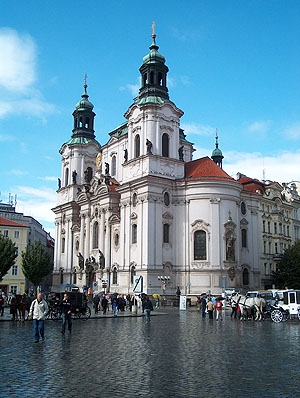 Baroko je v celkovem vzhledu Staromestskeho namesti zastoupeno vice nez dustojne kostelem sv. Mikulase z roku 1735 od Kiliana Ignace Dientzenhofera. Kopule mezi vezemi ma vysku 46,5 m, obe veze jsou o jeden metr vyssi. Zpocatku se mohlo po schodisti vystoupat pouze do jedne z vezi, do druhe veze bylo vlozeno nove schodiste teprve v roce 1904. Do te doby byla spojena s prvni vezi pouze drevenou lavkou na vnejsku pruceli. Ta nemela zabradli a jeji prechod byl tak kaskaderskym vykonem.
Baroko je v celkovem vzhledu Staromestskeho namesti zastoupeno vice nez dustojne kostelem sv. Mikulase z roku 1735 od Kiliana Ignace Dientzenhofera. Kopule mezi vezemi ma vysku 46,5 m, obe veze jsou o jeden metr vyssi. Zpocatku se mohlo po schodisti vystoupat pouze do jedne z vezi, do druhe veze bylo vlozeno nove schodiste teprve v roce 1904. Do te doby byla spojena s prvni vezi pouze drevenou lavkou na vnejsku pruceli. Ta nemela zabradli a jeji prechod byl tak kaskaderskym vykonem.
Ke vstupu do kostela stoupa pulkruhove schodiste, ktere ma N schodu.
Baroque is represented in the overall appearance of the Old Town Square by the St. Nicolas Church from 1735 built by Kilian Ignac Dientzenhofer. The dome between the towers is 46,5m high, both towers are one meter higher. Originally, it was possible to climb up stairs in only one tower, the other staircase was inserted in the other tower in 1904. Until then the latter tower was connected to the former one with a wooden bridge on the outside of the facade. It did not have any railings, so crossing the bridge was a stunt.
There is a semi-circular staircase leading up to the entrance of the church, which has N stairs.
O – Staronova synagoga / Old-New Synagogue
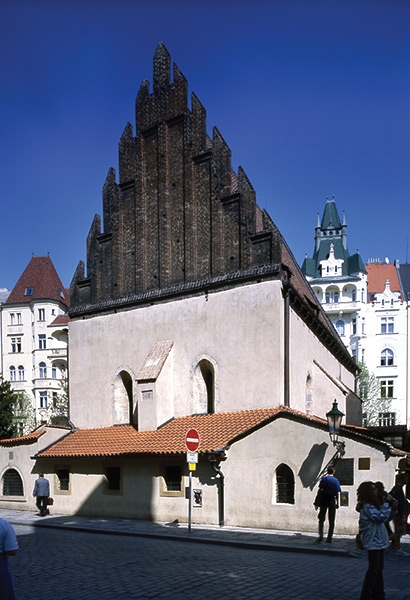 Staronova synagoga v Praze je jedna z nejstarsich synagog v Evrope, ktera se stale pouziva k nabozenskym obradum a je take nejstarsi dochovanou stavbou Josefova. Vznikla nekdy ve druhe polovine trinacteho stoleti, jeste na puvodnich naplavkach Stareho mesta pred zvysenim okolni urovne o 1–3 m jako soucasti protipovodnoveho opatreni ve 13. stoleti. Se vznikem synagogy je spojovan i vznik blizkeho zidovskeho hrbitova Zidovska zahrada.
Staronova synagoga v Praze je jedna z nejstarsich synagog v Evrope, ktera se stale pouziva k nabozenskym obradum a je take nejstarsi dochovanou stavbou Josefova. Vznikla nekdy ve druhe polovine trinacteho stoleti, jeste na puvodnich naplavkach Stareho mesta pred zvysenim okolni urovne o 1–3 m jako soucasti protipovodnoveho opatreni ve 13. stoleti. Se vznikem synagogy je spojovan i vznik blizkeho zidovskeho hrbitova Zidovska zahrada.
Ke Staronove synagoze se vaze i rada povesti. Jedna z nich pravi, ze zde Maharal ulozil na pude Golema, pote co ho deaktivoval vyjmutim tajne kabalisticke formule z jeho ust. Maharal mel udajne Golema uspat az po zacatku Sabatu, kdy byl nucen prerusit bohosluzbu po odzpivani zalmu 92 a 93, kterymi se vita Sabat, a porusil tak zakaz prace. Po navratu do synagogy zacal proto oba zalmy zpivat znovu, jako by se nic nestalo. Tento liturgicky zvyk se ve Staronove synagoze udrzel dodnes a zalmy 92 a 93 se zpivaji dvakrat.
Od nalezeni Golema na pude Vas deli pouze OO zeleznych stupacek na stene synagogy. O je 19.
The Old-New Synagogue in Prague is one of the oldest synagogues in Europe, it is still active in religious services and also one of the oldest preserved buildings in Josefov. It was completed in the 2nd half of the 13th century, still on the original wharves of the Old Town before raising the surrounding level by 1-3m as part of the anti-flood arrangements in the 13th century. Origination of the near-by Jewish cemetery called Jewish Garden is connected to the building of the synagogue. Legends are told about the Old-New Synagogue. One of them says that Maharal of Prague laid Golem in the attic after deactivating him extracting a secret cabalistic formula from his mouth. Maharal was said to sleep Golem after the beginning of Sabbath, he had to interrupt the services after singing psalms 92 and 93 (welcoming the Sabbath), thus breaking the ban to work. After returning to the synagogue he started to sing both psalms again as if nothing had happened. This liturgical habit has been kept in the Old-New Synagogue until today, so psalms 92 and 93 are sung twice.
To find Golem you have to climb OO iron creepers on the wall of the Synagogue. O is 19.
P – Maiselova synagoga / Maisel Synagogue
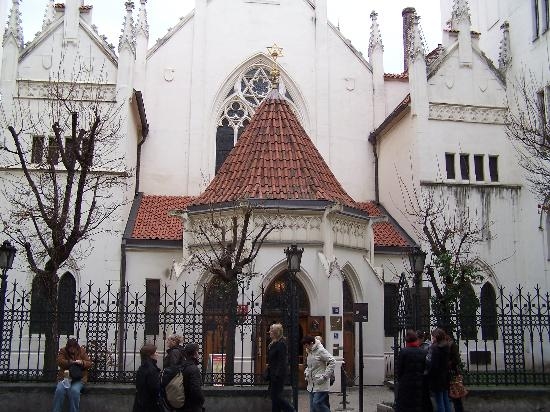 Puvodne renesancni Maiselova synagoga byla vybudovana v letech 1590 - 1592 primasem Zidovskeho mesta Mordechajem Maiselem, ktery financoval rozsahlou renesancni prestavbu ghetta. Po pozaru v roce 1689 byla prestavena v baroknim stylu, i tuto podobu ale nakonec potlacila zasadni gotizujici prestavba podle projektu prof. A. Grotta z roku 1905. V soucasne dobe Maiselova synagoga slouzi jako vystavni prostor a depozitar Zidovskeho muzea.
Puvodne renesancni Maiselova synagoga byla vybudovana v letech 1590 - 1592 primasem Zidovskeho mesta Mordechajem Maiselem, ktery financoval rozsahlou renesancni prestavbu ghetta. Po pozaru v roce 1689 byla prestavena v baroknim stylu, i tuto podobu ale nakonec potlacila zasadni gotizujici prestavba podle projektu prof. A. Grotta z roku 1905. V soucasne dobe Maiselova synagoga slouzi jako vystavni prostor a depozitar Zidovskeho muzea.
Na vrcholu pruceli uvidite symbolickych PP rimskych cisel.
Originally renaissance Maisel Synagogue was built in 1590-1592 by the primate of the Jewish Town Modechaj Maisel, who financed a vast renaissance reconstruction of the ghetto. After fire in 1689 it was rebuilt in the Baroque style, but also this version was suppressed in the end with a fundamental gothic reconstruction according to the design by prof. A. Grott from 1905. Today the Maisel Synagogue serves as exhibition area and depository of the Jewish Museum.
You can see symbolic PP roman numbers on the top of the facade.
Q – Pinkasova synagoga / Pinkas Synagogue
 Pinkasova synagoga v Praze byla vystavena roku 1535 Aharonem Mesulamem Horowitzem a pozdeji v 16. stoleti pojmenovana po krakovskem rabinu Pinkasovi. Od 2 sv. valky synagoga slouzi jako pamatnik obetem holocaustu, steny synagogy jsou uvnitr pokryty 77 297 jmeny ceskych zidu, kteri behem 2. svetove valky zahynuli v koncentracnich taborech, transportech nebo pochodech smrti a nebylo znamo misto jejich posledniho odpocinku nebo nemaji hrob. V roce 1968 byl Pamatnik uzavren, nebot spodni voda zacala stavbu ohrozovat. Pri pracich na hloubkove izolaci budovy byly objeveny podzemni prostory se starou studnou a ritualni lazni.
Pinkasova synagoga v Praze byla vystavena roku 1535 Aharonem Mesulamem Horowitzem a pozdeji v 16. stoleti pojmenovana po krakovskem rabinu Pinkasovi. Od 2 sv. valky synagoga slouzi jako pamatnik obetem holocaustu, steny synagogy jsou uvnitr pokryty 77 297 jmeny ceskych zidu, kteri behem 2. svetove valky zahynuli v koncentracnich taborech, transportech nebo pochodech smrti a nebylo znamo misto jejich posledniho odpocinku nebo nemaji hrob. V roce 1968 byl Pamatnik uzavren, nebot spodni voda zacala stavbu ohrozovat. Pri pracich na hloubkove izolaci budovy byly objeveny podzemni prostory se starou studnou a ritualni lazni.
Na zelezne brane k synagoze je Q zidovskych hvezd .
Pinkas Synagogue in Prague was built by Aharon Mesulam Horowitz in 1535 and later in the 16th century named after the royal rabbi Pinkas. Since the WWII the Synagogue represents the memorial to the victims of the holocaust. The walls of the Synagogue inside are covered with 77 297 names of Czech Jews who died in the concentration camps, transports or death marches during the WWII, and whose place of the last rest was not known or they had no graves. In 1968 the Memorial was closed because underground water was endangering the building. During works on the depth isolation of the building there were discovered underground spaces with old well and ritual bath.
There are Q Jewish stars on the iron gate to the Synagogue.
R – Rudolfinum
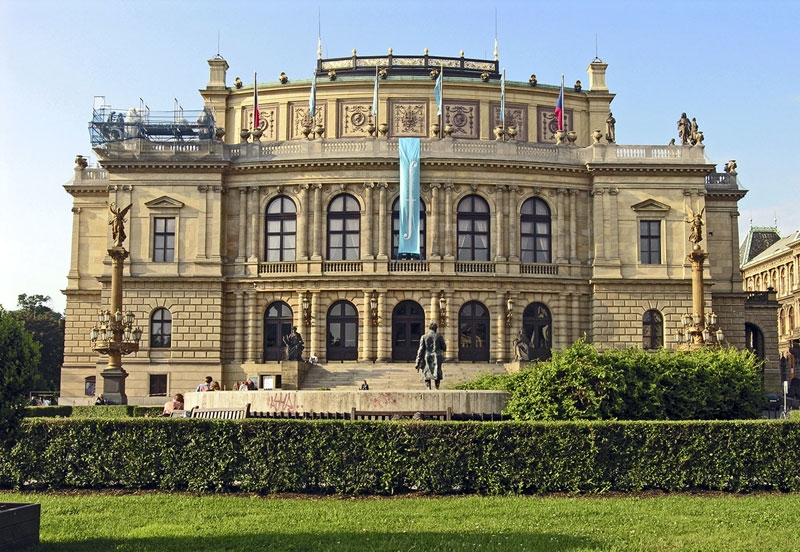 Rudolfinum je jednou z nejvyznamnejsich novorenesancnich staveb Ceske republiky. Svym pojetim viceuceloveho domu pro umeni byla v dobe sveho vzniku unikatem evropskeho vyznamu. Za svuj vznik vdeci financnimu domu Ceske sporitelny, ktera se v 19. stoleti nazyvala Böhmische Sparkasse. Tento nejstarsi penezni ustav v Praze tak chtel oslavit 50. vyroci sveho zalozeni. Nakladem 2 milionu zlatych byla postavena velkolepa budova hodna ceske kulturni tradice, ktera v sobe spojila provoz koncertnich produkci konzervatore, galerie a muzea. Je spolecnym dilem dvou vyznamnych ceskych architektu Josefa Zitka a Josefa Schultze, jejichz navrh zvitezil v soutezi, kterou roku 1874 vypsala Ceska sporitelna. Pro oba architekty byla nejlepsim doporucenim jejich dosavadni prace. Josef Zitek stavel Narodni divadlo, Josef Schultz Narodni muzeum. Slavnostnimu otevreni dne 7. unora 1885 byl pritomen i rakousky korunni princ Rudolf, na jehoz pocest byla budova nazvana Rudolfinum. Od roku 1946 je centrem prestizniho mezinarodniho festivalu Prazske jaro.
Rudolfinum je jednou z nejvyznamnejsich novorenesancnich staveb Ceske republiky. Svym pojetim viceuceloveho domu pro umeni byla v dobe sveho vzniku unikatem evropskeho vyznamu. Za svuj vznik vdeci financnimu domu Ceske sporitelny, ktera se v 19. stoleti nazyvala Böhmische Sparkasse. Tento nejstarsi penezni ustav v Praze tak chtel oslavit 50. vyroci sveho zalozeni. Nakladem 2 milionu zlatych byla postavena velkolepa budova hodna ceske kulturni tradice, ktera v sobe spojila provoz koncertnich produkci konzervatore, galerie a muzea. Je spolecnym dilem dvou vyznamnych ceskych architektu Josefa Zitka a Josefa Schultze, jejichz navrh zvitezil v soutezi, kterou roku 1874 vypsala Ceska sporitelna. Pro oba architekty byla nejlepsim doporucenim jejich dosavadni prace. Josef Zitek stavel Narodni divadlo, Josef Schultz Narodni muzeum. Slavnostnimu otevreni dne 7. unora 1885 byl pritomen i rakousky korunni princ Rudolf, na jehoz pocest byla budova nazvana Rudolfinum. Od roku 1946 je centrem prestizniho mezinarodniho festivalu Prazske jaro.
Pred Rudolfinem najdete sochu jedne vyznamne ceske osobnosti, ktera se podle napisu dozila 6R let.
Rudolfinum is one of the most significant Renaissance buildings in the Czech Republic. Its conception of a multipurpose house for arts was unique in European scope in the time of its completion. It was built thanks to the financial house of Ceska sporitelna (Böhmische Sparkasse at that time). This oldest financial institution in Prague wanted to celebrate its 50 anniversary. The costs of 2 million guldens covered the construction of a monumental building which is worthy of the Czech cultural tradition, combining a concert hall of the Academy of Music, a gallery and a museum. It is a joint work of two significant Czech architects, Josef Zitek and Josef Schultz, whose design won the tender announced by Ceska sporitelna in 1874. The best reference for both architects were their previous works. Josef Zitek built the National Theatre. Josef Schultz built the National Museum. The ceremonial opening on 7 February 1885 was attended also by Austrian crown prince Rudolf, in whose honor the building was named Rudolfinum. Since 1946 it is the centre of the prestigious international festival Prague Spring.
You can find here a statue of one important Czech personality. According to the inscription, this personality died in age of 6R.
S – Sovovy mlyny / Sova's Mills
 Nejstarsi zminka o mlynech na Kampe pochazi az z roku 1393. Mlyny zalozil klaster benediktinek u sv. Jiri. Vyrazne zmeny v historicke podobe Sovovych mlynu jsou spojeny se jmenem Frantiska Odkolka. Jeho podnikavost dala celemu prostredi novou tvar. Roku 1858 si podava zadost o prestavbu mlyna na amerikansky, tedy na parni typ. Adaptoval mlyn, postavil dvoupatrovou budovu, kterou prodlouzil az do linie ulice. V zaveru stavby byly provedeny romanticke fasady, byla postavena strojovna a vysoky komin. V roce 1896 vsak mlyn vyhorel. Vyhorele mlyny na Kampe koupila prazska obec v roce 1920 a to je v podstate soucasny stav. V letech 2000-2001 byla provedena celkova rekonstrukce a Sovovy mlyny dnes slouzi nyni jako galerie a muzeum umeni.
Nejstarsi zminka o mlynech na Kampe pochazi az z roku 1393. Mlyny zalozil klaster benediktinek u sv. Jiri. Vyrazne zmeny v historicke podobe Sovovych mlynu jsou spojeny se jmenem Frantiska Odkolka. Jeho podnikavost dala celemu prostredi novou tvar. Roku 1858 si podava zadost o prestavbu mlyna na amerikansky, tedy na parni typ. Adaptoval mlyn, postavil dvoupatrovou budovu, kterou prodlouzil az do linie ulice. V zaveru stavby byly provedeny romanticke fasady, byla postavena strojovna a vysoky komin. V roce 1896 vsak mlyn vyhorel. Vyhorele mlyny na Kampe koupila prazska obec v roce 1920 a to je v podstate soucasny stav. V letech 2000-2001 byla provedena celkova rekonstrukce a Sovovy mlyny dnes slouzi nyni jako galerie a muzeum umeni.
V nedavne dobe se na brehu reky kousek od mlynu usadila tlupa zarive zlutych tucnaku. Jejich pocet +1 je SS.
The oldest mention of the mills on Kampa dates back to 1393. The mills were founded by the Benedictine monastery of the St. George. Significant changes in the historical appearance of Sova’s mills are connected with the name of Frantisek Odkolek. His drive gave the whole surrounding a new face. In 1858 he applied for permission to rebuild the mill into American, i.e. steam type. He adapted the mill, built a two-floor building which he prolonged out to the level of the street. In the end he had the Romantic facades carried out , the engine and the tall chimney built. However, in 1896 the mill burnt out. The burnt mills on Kampa were bought by the Prague city in 1920 and this applies until today. In 2000-2001 the general reconstruction was done and Sova’s mills serve today as a gallery and museum of arts.
Recently a group of bright yellow penguins has settled down on the bank of the river not far from the mill. Number of penguins +1 is SS.
T – Velkoprevorsky mlyn / Velkoprevorsky Mill
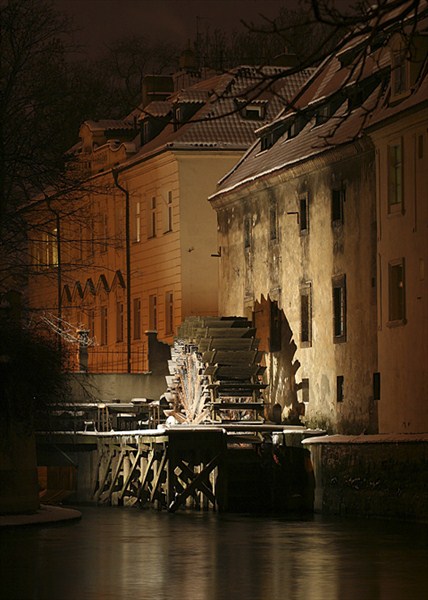 Renesancni mlyn pohaneny velkym drevenym kolem ponorenym do Certovky byl postaven v letech 1597-1600 za vlady Rudolfa II. Na stejne parcele vsak staval mlyn jiz od stredoveku. Nazev velkoprevorsky, odkazuje k vlastnikum mlyna - radu maltezskych rytiru, jejichz komenda se nachazela v bezprostredni blizkosti. Mezi radem a malostranskou obci se vsak o jeho vlastnictvi rozhorela rozsahla soudni pre, ktera trvala vice jak sto let. Napriklad v roce 1629 dosly udalosti tak daleko, ze malostransti budovu mlyna nasilim obsadili. Spor definitivne skoncil az roku 1795, kdy rad mlyn odprodal.
Renesancni mlyn pohaneny velkym drevenym kolem ponorenym do Certovky byl postaven v letech 1597-1600 za vlady Rudolfa II. Na stejne parcele vsak staval mlyn jiz od stredoveku. Nazev velkoprevorsky, odkazuje k vlastnikum mlyna - radu maltezskych rytiru, jejichz komenda se nachazela v bezprostredni blizkosti. Mezi radem a malostranskou obci se vsak o jeho vlastnictvi rozhorela rozsahla soudni pre, ktera trvala vice jak sto let. Napriklad v roce 1629 dosly udalosti tak daleko, ze malostransti budovu mlyna nasilim obsadili. Spor definitivne skoncil az roku 1795, kdy rad mlyn odprodal.
Vy si zde vsimnete velkeho mlynskeho kola, ktere ma TT lopatek.
The Renaissance mill driven by a big wooden wheel submerged in Certovka channel was built in 1597-1600 under the reign of Rudolf II. There was already a mill since the medieval times. The name Velkoprevorsky refers to the owners of the mill – the Sovereign Military Order of Malta, whose commendum lied nearby. The Order and the Lesser Town municipality started to sharply quarrel about the ownership at a court which took more than a hundred years. For example, in 1629 the situation went so far that the Lesser Town people took the building violently. The quarrel ended definitely only in 1795 when the Order sold the mill off.
Notice here the big mill wheel which has TT shovels.
U – Velkoprevorsky palac / Velkoprevorsky Palace
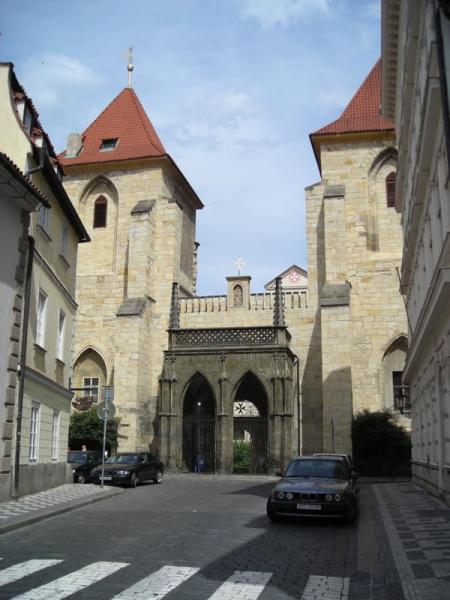 Neprilis znamy kostel Matky Bozi pod retezem s masivnimi, temer pevnostnimi vezemi a zajimavym preddvorim je v Praze jednim z nejmalebnejsich. Od zalozeni prvni ceske komendy maltezskych rytiru zvanych tez johanite v roce 1169 slouzi s vyjimkou padesatych let minuleho stoleti tomuto radu dodnes.
Neprilis znamy kostel Matky Bozi pod retezem s masivnimi, temer pevnostnimi vezemi a zajimavym preddvorim je v Praze jednim z nejmalebnejsich. Od zalozeni prvni ceske komendy maltezskych rytiru zvanych tez johanite v roce 1169 slouzi s vyjimkou padesatych let minuleho stoleti tomuto radu dodnes.
Povest vypravuje, ze klasterni brana byla na noc uzavirana silnym, bohate pozlacenym a tim i velice napadnym retezem, ktery tu zustal, i kdyz se klaster i chram pozdeji dostaly za zvetseny obvod mestskeho ohrazeni a jejich opevneni se zdalo byt zbytecne. Pocatkem husitskych valek byla Mala Strana citelne ponicena a tehdy se pry zlaty retez od klasterni brany zahadne ztratil. Jmeno kostelu ale zustalo.
Za povsimnuti stoji kovana brana, krome plachetnic na ni najdete take U koni.
The not much known Church of The Holy Mother Below the Chain with massive, almost fortress, towers and and interesting foreyard is one of the most picturesque in Prague. Since the foundation of the first commendum of the Maltese Knights Order called also the Johannites in 1169, it serves the Order until today, with the exception of the 1950s. The legend says that the church gate was closed for nights with a strong, richly gold-coated, so very striking chain, which stayed there even when the church and the basilica later got behind the municipal fencing perimeter and its fortification seemed to be meaningless. At the beginning of the Hussite wars the Lesser Town was legibly damaged and it was said to be then when the chain from the church gate was lost. The church however kept its name.
It is worth noticing the forged gate, you can find there, besides sailboats, also U horses.
V – Chram sv. Mikulase / St. Nicholas Cathedral
 Chram sv. Mikulase na Male Strane je casto povazovan za nejkrasnejsi barokni stavbu Prahy. Byl staven v nekolika etapach v letech 1704–1755 nejprve podle projektu Krystofa Dientzenhofera, pozdeji jeho syna Kiliana Ignace Dientzenhofera. V minulosti na vezi kostela drzeli sluzbu hlasni, kteri meli za ukol hlasit pripadne pozary ci bliziciho se nepritele. Za socialismu byla ve vezi vybudovana pozorovatelna Statni bezpecnosti, ze ktere bylo mozne sledovat americke a jugoslavske velvyslanectvi a pristupovou cestu k zapadonemeckemu velvyslanectvi. 15. dubna 2010 byla pozorovatelna s krycim nazvem „Kajka“ zpristupnena verejnosti, nachazi se v ni expozice, ktera dokumentuje cinnost spravy sledovani StB.
Chram sv. Mikulase na Male Strane je casto povazovan za nejkrasnejsi barokni stavbu Prahy. Byl staven v nekolika etapach v letech 1704–1755 nejprve podle projektu Krystofa Dientzenhofera, pozdeji jeho syna Kiliana Ignace Dientzenhofera. V minulosti na vezi kostela drzeli sluzbu hlasni, kteri meli za ukol hlasit pripadne pozary ci bliziciho se nepritele. Za socialismu byla ve vezi vybudovana pozorovatelna Statni bezpecnosti, ze ktere bylo mozne sledovat americke a jugoslavske velvyslanectvi a pristupovou cestu k zapadonemeckemu velvyslanectvi. 15. dubna 2010 byla pozorovatelna s krycim nazvem „Kajka“ zpristupnena verejnosti, nachazi se v ni expozice, ktera dokumentuje cinnost spravy sledovani StB.
Indicii na souradnicich je mala kulata bila cedulka napravo od hromosvodu s cislem V. (V je sude, pozor na souradnice, hromosvodu je tu vice.)
St. Nicolas Church in the Lesser Town is often considered the most beautiful Baroque building of Prague. It was built in several etapes in 1704-1755, first according to the project by Krystof Dientzenhofer, later by his son Kilian Ignac Dientzenhofer. In the past watchers served on the tower of the church tasked to report fires or approaching enemies. During the socialist era a watch post of the State Security was established in the tower enabling to monitor American and Yugoslav embassies and the access road to the West-German Embassy. On 15 April 2010 the watch post with cover name Kajka was opened to the public. There is an exposition documenting the activities of StB.
The variable on these coordinates is the small round white plate to the right from the lightning conductor with number V. (V is even, carefully with the coordinates, there are more lightning conductors on the cathedral.)
W – Morovy sloup Nejsvetejsi trojice / Plague Column of the Holy Trinity
 Velkolepy sloup v horni casti Malostranskeho namesti nechali v roce 1715 vztycit mestane jako vyraz diku za odezneni straslive morove rany, ktera v Praze vypukla o dva roky drive. V dobe moru se po Praze konaly prosebne bohosluzby pod sirym nebem, na jejichz miste byly pozdeji vztyceny sloupy se sochami svatych. Na Male Strane byly tri – na Hradcanskem, Maltezskem a Malostranskem namesti. Dvacet metru vysoky sloup tvori piskovcovy jehlan vykladany mramorem, na jehoz vrcholu je umisten symbol boziho oka. Na jizni strane je oltarni stul, ostatni tri strany zaujimaji symboly zivota, milosti a spasy.
Velkolepy sloup v horni casti Malostranskeho namesti nechali v roce 1715 vztycit mestane jako vyraz diku za odezneni straslive morove rany, ktera v Praze vypukla o dva roky drive. V dobe moru se po Praze konaly prosebne bohosluzby pod sirym nebem, na jejichz miste byly pozdeji vztyceny sloupy se sochami svatych. Na Male Strane byly tri – na Hradcanskem, Maltezskem a Malostranskem namesti. Dvacet metru vysoky sloup tvori piskovcovy jehlan vykladany mramorem, na jehoz vrcholu je umisten symbol boziho oka. Na jizni strane je oltarni stul, ostatni tri strany zaujimaji symboly zivota, milosti a spasy.
Na jedne ze soch na jizni strane sloupu zjistite, ze se jedna o kopii od M. a J. Cacherovych z roku 19WW. (WW je prvocislo.)
The magnificent column in the higher part of the Lesser Town Square was raised in 1715 by citizens as a token of gratitude for the end of a terrible plague strike which burst out in Prague two years before. In the times of the plague open-air pleading worships were held around Prague and columns with statues of the Saints were raised on these places later. In the Lesser Town there were three – on the Castle District Square, on the Maltese Square, and on the Lesser Town Square. The twenty meters tall column is formed by a sandstone pyramid inlaid with marmor, with the symbol of the Holy Eye on the top. On the Southern side there is an altar-table, the other three sides carry the symbols of life, mercy and salvation.
You can find out on one of the statues on the southern part of column that it is a copy by M. and J. Kacer from 19WW. (WW is prime number.)
X – Kostel Panny Marie ustavicne / St. Mary's Church of the Assumption
 Jste u nenapadneho kostela v horni casti Nerudovy ulice drive patricimu konventu Theatinu. Tento dnes jiz malo znamy rad prisel do Ceskeho kralovstvi r. 1666. Po ziskani zdejsich pozemku roku 1679 clen radu a nejoriginalnejsi architekt sve doby – Guarino Guarini – narysoval idealni plan prazskeho kostela, zalozeny na pruniku stereometrickych teles a doplneny dynamicky zprohybanym prucelim, ktery byl ovsem pro tehdejsi prazske prostredi pro svoji pokrocilost neprijatelny. U pocatku nynejsi podoby stal nakonec zrejme burgundan pusobici v Praze – Jean Baptiste Mathey. Konecnou podobu vsak pravdepodobne ovlivnil az Jan Blazej Santini, jehoz rukopis je mozno rozpoznat ve tvarovani architektonickych prvku zejmena v interieru.
Jste u nenapadneho kostela v horni casti Nerudovy ulice drive patricimu konventu Theatinu. Tento dnes jiz malo znamy rad prisel do Ceskeho kralovstvi r. 1666. Po ziskani zdejsich pozemku roku 1679 clen radu a nejoriginalnejsi architekt sve doby – Guarino Guarini – narysoval idealni plan prazskeho kostela, zalozeny na pruniku stereometrickych teles a doplneny dynamicky zprohybanym prucelim, ktery byl ovsem pro tehdejsi prazske prostredi pro svoji pokrocilost neprijatelny. U pocatku nynejsi podoby stal nakonec zrejme burgundan pusobici v Praze – Jean Baptiste Mathey. Konecnou podobu vsak pravdepodobne ovlivnil az Jan Blazej Santini, jehoz rukopis je mozno rozpoznat ve tvarovani architektonickych prvku zejmena v interieru.
Na kostelu zjistite, ze byl vystaven roku 17XX. X je 17.
You are at a decent church in the higher part of Neruda Street formerly belonging to the Convent of Theatins. This not well known order came to the Czech Kingdom in 1666. After acquisition of local plots in 1679, one of the members of the order and the most original architect of his times – Guarino Guarini – drafted an ideal plan of a Prague church, based on the intersection of stereo metric spheres combined with dynamically bent facade. The plan was however unacceptable due to its forwardness for the Prague environment of the time. In the end, a Burgund living in Prague – Jean Baptiste Mathey – stood at the beginning of its today form. The final form probably was influenced by Jan Blazej Santini, whose pen can be distinguished in the forming of the architectonic elements, especially in the interior.
You can find out on the church that it was built in 17XX. X is 17.
Y – Prazsky hrad / Prague Castle
 Vystoupali jste na nejvyssi bod sve cesty, Prazsky hrad. Byl postupne prestavovan v prubehu celeho tisicileti, svou nynejsi podobu ziskal az roku 1929. Prvni zminky jsou z 9. stoleti, kdy se stal sidlem Premyslovcu. Od te doby byl tradicnim sidlem ceskych panovniku, od roku 1918 zde sidli cesky prezident. Jde o velky komplex budov, podle Guinnessovy knihy rekordu je svymi rozmery 570 m delky a 130 m sirky nejvetsim hradem na svete.
Vystoupali jste na nejvyssi bod sve cesty, Prazsky hrad. Byl postupne prestavovan v prubehu celeho tisicileti, svou nynejsi podobu ziskal az roku 1929. Prvni zminky jsou z 9. stoleti, kdy se stal sidlem Premyslovcu. Od te doby byl tradicnim sidlem ceskych panovniku, od roku 1918 zde sidli cesky prezident. Jde o velky komplex budov, podle Guinnessovy knihy rekordu je svymi rozmery 570 m delky a 130 m sirky nejvetsim hradem na svete.
Dominantou Hradu je chram sv. Vita. Jeho stavba zacala za Karla IV. roku 1344 pod vedenim Matyase z Arrasu a pozdeji Petra Parlere. Husitske valky ale stavbu prerusily a tehdy nikdo netusil, ze jeho zapadni polovina s osmdesatimetrovymi vezemi bude dostavena az temer po 600 letech. V katedrale jsou ulozeny ceske korunovacni klenoty a pochovani mnozi cesti vladci.
Prazsky hrad je povazovan za symbol mesta i cele Ceske Republiky.
Az se pokochate vyhlidkou, tak si predtim, nez se odsud vydate po Zameckych schodech dolu na posledni zastavku teto prochazky, jeste vsimnete sochy Tomase Garrigua Masaryka. Je na ni maly napis Otakar Spaniel 19YY.
You have reached the highest point of your tour, the Prague Castle. It was gradually rebuilt during the whole millennium, it got its nowadays form only in 1929. First mentions are from the 9th century, when it became the seat of Premyslid dynasty. Since then it was a traditional seat of Czech kings, since 1918 it is a seat of Czech Presidents. It is a huge complex of buildings, according to the Guinness World Records it is the biggest castle in the world by its size: 570m long and 130m wide.
The dominance of the Castle is the St. Vitus Cathedral. Its building was started under the reign of Charles IV in 1344 and was led by Matyas of Arras and later Petr Parler. The Hussite wars suspended the building and nobody thought then that its Western half with the eighty-meter-high towers would be finished only almost 600 years later. The Czech crown jewels are kept in the Cathedral and many Czech kings are buried there.
The Prague Castel is considered the symbol of the city and the whole Czech Republic.
After you enjoy the view, notice the statue of Tomas Garrigue Masaryk before you go down the castle stairs to the last stop of this walk. There is a small writing on the statue: Otakar Spaniel 19YY.
Z – Valdstejnsky palac / Wallenstein Palace
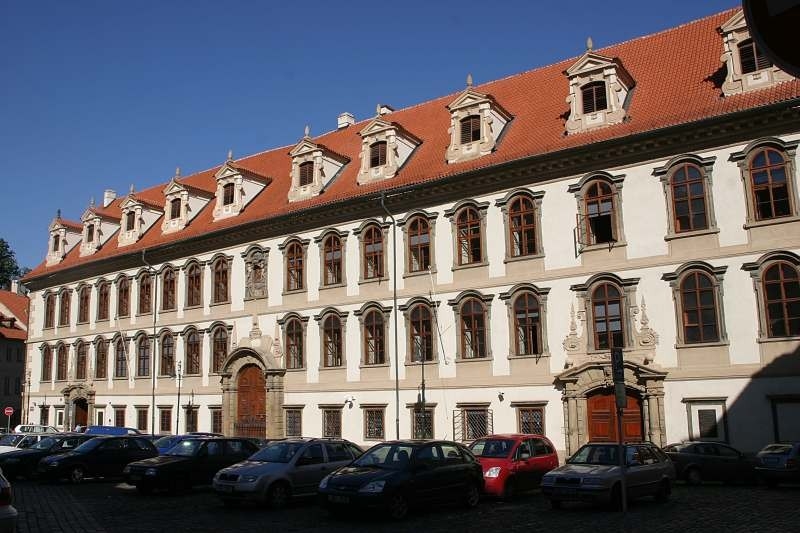 Stojite pred Valdstejnskym palacem a jste temer u konce sve cesty. Tento palacovy komplex dal vystavet v letech 1623-1630 jeden z nejmocnejsich slechticu te doby Albrecht Vaclav Eusebius z Valdstejna. Palac mel svou velkoleposti zastinit i Prazsky hrad. Puvodne nevyznamny a chudy prislusnik ceske slechty se vyhodnymi snatky i koupemi domohl znacneho majetku i postaveni na cisarskem dvore. Vojevudce byl povyseny roku 1623 na knizete, r. 1627 jmenovany vevodou frydlantskym a r. 1629 vevodou maklenburskym. V roce 1625 se stal generalissimem cisarske armady. Roku 1632 bojoval se Sasy a se Svedy se stretl v bitvach u Norimberku a u Lützenu. V roce 1634 byl prohlasen cisarskymi dekrety za zradce rise, v Chebu byl zavrazden cisarskymi dustojniky a jeho majetek v Cechach byl zkonfiskovan. Valdstejnsky palac vsak pretrval v nezmenene podobe do soucasnosti a jako jeden z nejprestiznejsich palacu Cech je dnes sidlem Senatu.
Stojite pred Valdstejnskym palacem a jste temer u konce sve cesty. Tento palacovy komplex dal vystavet v letech 1623-1630 jeden z nejmocnejsich slechticu te doby Albrecht Vaclav Eusebius z Valdstejna. Palac mel svou velkoleposti zastinit i Prazsky hrad. Puvodne nevyznamny a chudy prislusnik ceske slechty se vyhodnymi snatky i koupemi domohl znacneho majetku i postaveni na cisarskem dvore. Vojevudce byl povyseny roku 1623 na knizete, r. 1627 jmenovany vevodou frydlantskym a r. 1629 vevodou maklenburskym. V roce 1625 se stal generalissimem cisarske armady. Roku 1632 bojoval se Sasy a se Svedy se stretl v bitvach u Norimberku a u Lützenu. V roce 1634 byl prohlasen cisarskymi dekrety za zradce rise, v Chebu byl zavrazden cisarskymi dustojniky a jeho majetek v Cechach byl zkonfiskovan. Valdstejnsky palac vsak pretrval v nezmenene podobe do soucasnosti a jako jeden z nejprestiznejsich palacu Cech je dnes sidlem Senatu.
Pokud mate cas a je otevreno, doporucuji zajit i do Valdstejnske zahrady, jinak Vám bude stačit, když zjistíte, že na vstupních dveřích je Z stříbrných prvků.
You are standing in front of the Wallenstein Palace and you are almost at the end of your tour. This palace complex was built in 1623-1630 by one of the most powerful nobles of the time Albrecht Vaclav Eusebius from Wallenstein. The Palace should have overshadowed the Prague Castle with its grandiosity. Originally insignificant and poor member of the Czech nobility came to a vast possession and position on the imperial court through profitable marriages and acquisitions. A Commander was promoted in 1623 to a Prince, in 1627 named the Duke of Frydlant and in 1629 the Duke of Maklenburg. In 1625 he became the Generalissimo of the imperial army. In 1632 he fought the Saxons and he encountered the Swedes in the battles of Nürnberg and Lützen. In 1634 he was pronounced a traitor by imperial decrees, murdered by imperial officers in Cheb and his property in Bohemia was confiscated. Wallenstein Palace has endured unchanged until today and it is a seat of the Senate as one of the most prestigious palaces in the Czech Republic.
If you’ve go some time and it is open, visit of the Wallenstein garden is highly recommended. Otherwise just discover that there are Z silver componenets on the entrance door.

Free counters